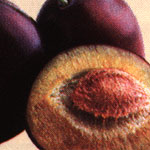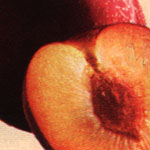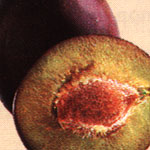


El Dorado Elephant Heart Friar



Italian Kelsey Laroda



Friar President Queen Rosa



Red Beaut Roysum Santa Rosa



Simka

FoodFood InformationFruitDeciduous
Plums are native to the Orient, Europe, and North America. While they
date back hundreds of years, most of the ones we now enjoy are new improved
varieties that have been introduced in the last four decades. There are
countless documented varieties and new ones continually come on line.
Botanically the plum is a drupe and is related to the peach, nectarine,
apricot, and almond. Plums come in assorted sizes, shapes, skin colors,
and even flesh colors. Some varieties are slightly larger than a marble,
others are much larger than a jumbo egg. They can be either round or oval
in shape. There is a wide range of skin colors: green, yellow, orange, purple,
every shade of red, and black. Most plums have a yellow-colored flesh, but
a few varieties have a red flesh. Most are clingstone, but several are freestone.
Even with all this diversity of color, shape, and size, plums can be divided
into two distinctively different groups that are known as European plums
and Japanese plums.
The European varieties are usually, but not necessarily, freestone. They
all have yellow flesh, but the thing that sets them apart is that they always
have a purple skin (sometimes it looks almost blue if it has a lot of bloom).
The Japanese plums come in a wide range of colors but never have the telltale
purple skin color. Most varieties are also yellow in flesh, but some have
a bright red flesh. Unlike the European plums, which for the most part are
freestone, most, but not all, of the Japanese varieties are clingstone.
The Japanese plums are usually tastier and juicier than the European varieties.
They are nearly always eaten out of hand or used as a fresh fruit, since
they dissolve when cooked and are not suitable for drying in the sun to
be marketed as dried fruit. The European plums have a milder flavor and
a meatier texture. Some varieties are quite good when eaten out of hand,
but most are at their best when cooked or baked. These are the only types
that are sun-dried and sold as dried fruit.
The terms plum and prune always cause some confusion, possibly because the
Latin word for plum is prunus. Botanically there is no difference between
a plum and a prune. Originally in the English language, the words plum and
prune were used as synonyms. Today, to make it less confusing, the Japanese
varieties are called plums and the European varieties are usually called
fresh prunes. The sun-dried fruit are also called prunes.
American plums are in season from mid-May until October. America imports
plums from Chile during January, February, and March. Almost 90 percent
of America's plums are grown in California. The first California plums of
the year arrive near the end of May and are of a variety called the Red
Beaut. This is not one of our better eating or holding varieties but
is in great demand and brings top dollar because it is the first plum on
the scene. You'll do better to skip these first arrivals and wait about
three to four weeks for the more flavorful, better textured Santa Rosa
plums.
Except for a jade-green-skinned variety called the Kelsey, the best
flavored Japanese-type plums are either bright red or dark red in skin color.
The dark red varieties are round and have very small pits. They have good
size, lots of juice, and a refreshing tart-sweet flavor. The top varieties
in this group, in order of merit, are the LaRoda, Eldorado, Queen
Anne, Friar, and Nubiana. The brighter-red-skinned varieties are usually
more oval in shape. They have larger stones than the dark red varieties
and a slightly more tart, but also delicious, flavor. The varieties in this
group are easy to recognize by name because they usually end with the word
Rosa. There are the Santa Rosa, Queen Rosa, Gar Rosa, and Simka
Rosa. The Simka Rosa is the largest fruit in the Rosa group and is sometimes
called the New Yorker Plum. (Over the years this variety has increased the
income of the dental profession. Along with the fairly large and very obvious
pit that is easily removed, there is usually a tiny chip of a pit embedded
in the flesh of the plum. It lurks unnoticed until you bite into it.)
All of the above-mentioned varieties have a yellow flesh. There are some
fine red-fleshed varieties that are as flavorful as they are colorful. The
old Duarte variety, which was the original red-flesh plum, lost favor
not because it lacked flavor but because its skin would split open in several
areas as it reached full maturity. The newer red-fleshed varieties are very
popular in California but are seldom shipped out of the state because they
are quite fragile when ripe and are often too tender to risk lengthy transport.
The red-fleshed varieties include the Frontier, Mariposa, Carol Harriss,
and Ace, which looks like a huge Duarte. One red-fleshed variety
warrants special attention because its name accurately describes its contents:
It is called the Elephant Heart.
There are two green-skinned varieties that also warrant special attention.
They look somewhat alike in color and are very much alike in shape and size.
As they ripen, the green fades to yellow and then bronze. The lighter green
variety, which arrives late in June, is called the Wickson and is
about as dry and flavorful as an unsalted boiled potato. The jade green
variety, which follows in a few weeks, is called the Kelsey. There
is no finer plum than the Kelsey. If you buy green-skinned plums, ask for
Kelseys by name and avoid the Wicksons. Very often these two varieties are
marketed as Green Gage plums, which they are not. The true Green Gage is
grown in England and is a smaller horse of the same color.
The European-type plums don't reach the market until August. The most popular
and the biggest crop are the small, purple, freestone prunes. These are
grown not only in California but in the Pacific Northwest, Michigan, and
New York. Washington State ranks number one in production. They are most
commonly known as fresh prunes or Italian prunes but, depending on the ethnic
balance of a neighborhood, may also be known as German prunes or Hungarian
prunes. They are usually in good supply and sell at moderate prices. These
freestone prunes are fairly good when eaten out of hand as a fresh fruit,
but achieve their top flavor and top texture when used in baking. They also
are excellent when stewed in sugar syrup.
One variety of European-type plum, called the Damson, is excellent
for making jams and preserves. These are very small in size and are too
firm and tart to eat raw, but they are fine when cooked. In Grandma's era,
when many people put up homemade jellies, Damsons were a big item. Today
they have all but disappeared.
In mid-September we get two very large-sized varieties of European-type
plums. One of these, which resembles a huge fresh prune, is called the Empress
and has a pretty good flavor. The other variety is called the President
plum. These large purple plums are graceful fruits that look like winners
but taste like losers. The Presidents arrive in huge supply just as the
superior Japanese varieties are fading out. They are one of our poorest-flavored
plums. When consumed while firm and green, they lack flavor and aren't very
juicy. If allowed to ripen, they are very dry but do have good flavor, they
taste like soap.
Another purple-skinned variety to avoid is aptly named. This variety is
called the Tragedy plum and they do have a tragic flavor. These small
purple plums are grown in California and arrive in July about a month before
the look-alike fresh prunes. Shoppers, mistaking them for the fresh Italian
prunes, buy the Tragedies. They haven't nearly as much flavor raw or cooked.
Thankfully, fewer Tragedies arrive in market each year.
When shopping for plums, select those that have good color, are at least
medium-sized, and are not bruised. Remember to avoid buying the first plum
varieties that arrive in market in early May. Wait until June for more flavorful,
less costly varieties. Enjoy plums during June, July, August, and early
September. When the red-skinned varieties go out of season in mid-September,
don't substitute with the large, attractive purple President plums, which
lack flavor.
Nearly all the stone fruits (nectarines, peaches, and plums) should be purchased
when firm and at high color, then allowed to ripen for a few days at room
temperature. Once they attain a slight yield (or give) to gentle pressure,
they should be stored in the refrigerator until used. Remember that slightly
under ripe is preferable to overripe. The one exception to this rule is
the apricot. You can't have an apricot that is too ripe. They are at flavor
best when the texture is almost fluid.
















WHEN TO BUY: At peak June, July, and August
WHAT TO LOOK FOR: Firm, colorful, not bruised fruit
HOW TO STORE: Ripen at room temperature; refrigerate when ready to eat
Deamer 5/97